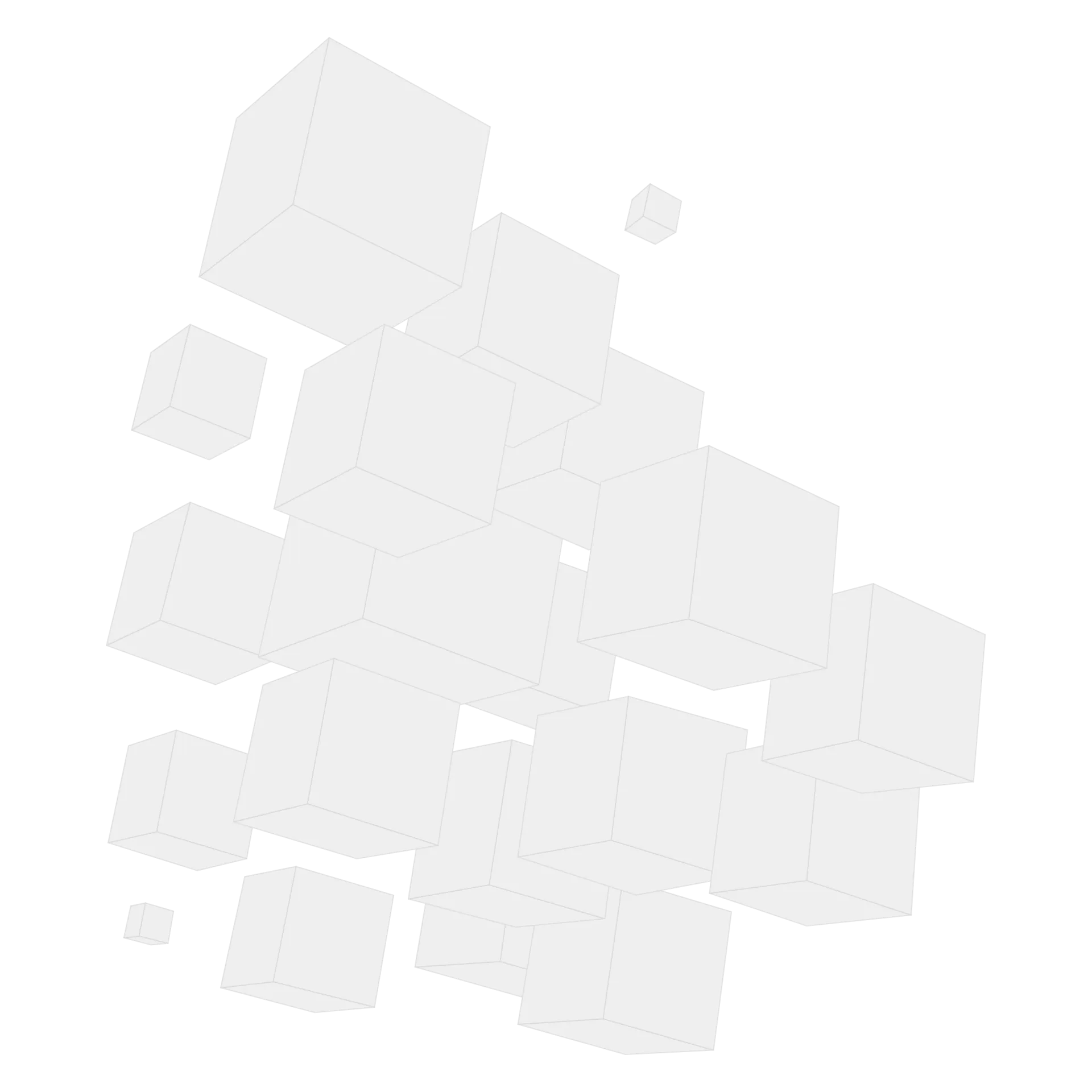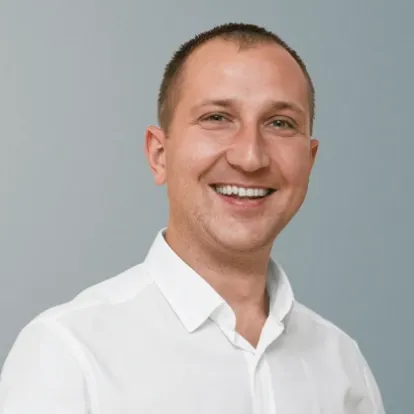Monolith To Microservices Migration


Amazon, Uber, and Netflix are the top real-world apps that were initially launched as monoliths. Further, they have migrated to microservices because of the need to implement new features easily with loose coupling.
The microservices implementation statistics say that only 1% of companies plan to use the monolithic database management and architecture. The other 99% of surveyed companies reported they have already switched or plan to adopt microservices in the future after refactoring monolith challenges.
What’s wrong with a monolith? The top three issues of the monolithic architecture at scale are:
- slow delivery
- poor stability
- insufficient scalability
The following problems increase fast when the complexity of an application grows.
Monolith refactoring guide 2025
The process of moving from monolith to microservices involves seven crucial stages. They help understand the current problems and define the best solution refactoring strategy with bounded context analysis.

1. Discover if Monolith is a Problem Source
Migration from monolith to microservices isn’t the all-purpose solution to all the problems that arise when monolith apps scale up with data integrity issues.
Ensure that project challenges are caused by the downsides of a monolith but not the following issues.
- Insufficient business analysis. Your team of software engineers may dedicate a lot of time to eliciting business functionality requirements because of a lack of business analysis. It negatively affects the performance of software engineers as they dedicate fewer hours to developing new features.
- Poor team management. The most popular gaps in team management processes are the absence of regular meetings or feedback-sharing sessions. Also, you may lack defined roles and responsibilities that are usually indicated in a RACI matrix.
- Unoptimized development processes. Many factors can drive poor development process management with continuous integration (CI). For instance, you may lack Git workflow rules, tech meetings, linters and autotests, code review sessions, etc.
- Insufficient team seniority. A team dedicated to a project may need more expertise to manage a large codebase and implement new functionality efficiently with data ownership.
- Lack of testing. The poor involvement of a quality assurance team may lead to a large number of bugs being unfixed in a deployed product without end-to-end testing.
Stage #1 outcome:
Understanding if the monolith downsides are the problem source in a project with organizational structures.
2. Check if Issues Can be Solved Quickly
We recommend checking if small tweaks and adjustments can solve performance issues before refactoring a monolith to microservices.
Check if the following solutions are applicable to your product and can help address tech issues.
- Code scaling. Containerize your application, implement an orchestration tool like kubernetes infrastructure, implement continuous deployment (CD) pipelines, etc.
- Database scaling. Data replication and sharding are the two top ways to optimize a database used in a monolith application.
- Small adjustments. The implementation of non-blocking code or SQL query optimization with data schema are minor tweaks that can help address tech issues.
Stage #2 outcome:
Understanding if it is required to convert a monolith to microservices to solve detected issues.
Do you need switch to microservices?

Business First
Code Next
Let’s talk
3. Optimize a Monolith
The better a monolithic application is optimized, the smoother and faster the refactoring process will be run with data consistency and transactions.
At CodeIT, we recommend following the best practices to convert a monolith to microservices smoothly.
- Domain-driven design. The approach helps software engineers change the code structure to make it well-aligned with the business logic.
- Clean architecture. The adherence to this software design philosophy helps improve the maintainability and scalability of an app with database mappings. Also, it promotes detachment from third-party frameworks and libraries.
- SOLID guidelines. The set of principles promotes the development of a modular software design with reusable components and static data configuration.
Stage #3 outcome:
An optimized monolithic application as per the DDD/Clean Architecture guidelines. Having a modular monolith with minimized dependencies will help to speed up the refactoring process with technology selection.
4. Choose a Migration Approach
The two major ways to handle monolith to microservices migration are complete refactoring and incremental migration with service decomposition.
Complete rewrite
The entire codebase is refactored at once. Until the migration process is completed, new features are implemented in the monolithic codebase. Further, they will need to be implemented into the microservice codebase.
The option is applicable if:
- the codebase is small
- new features are released rarely
- existing modules are well-defined and can be easily separated with domain boundaries
Strangler application
The application is being refactored incrementally with a strangler fig pattern. New features are developed as distinctive services. Meanwhile, the most crucial features are extracted from a monolith and implemented as microservices.
The option should be considered in the following cases:
- the architecture is large and complex
- you need to roll out new features constantly with event-driven architectures
- business requirements are unclear or change frequently
Stage #4 outcome:
A defined monolith to microservices migration approach with service discovery.
5. Prioritize Features to Extract
When you select the strangler application approach, you have to define features that should be extracted from the monolith first.
The process of extracting a service is time- and resource-consuming. Moreover, extracting all the services from a monolith is not always necessary. Therefore, it’s vital to identify services and prioritize them by considering the following criteria:
- extraction will accelerate further functionality development and enrichment
- extraction will help solve performance, scalability, or stability issues with load balancing
- extraction will enable the opportunity to extract other services
We recommend defining domain entities along with business logic for managing them. It is one of the core aspects of the smart service extraction analysis strategy.
Stage #5 outcome:
A list of the most important features that should be extracted first with an iterative and incremental approach.
Hire experienced developers to refactor app

Business First
Code Next
Let’s talk
6. Extract Features from a Monolith
Onboard software engineers to a project. They are responsible for extracting new services and incorporating new technologies if needed with programming language flexibility. Create separate teams of developers assigned to one or several microservices with autonomy.
The strangler application approach needs you to incrementally cut off the functionality of a monolith and implement it as distinctive microservices with bounded contexts.
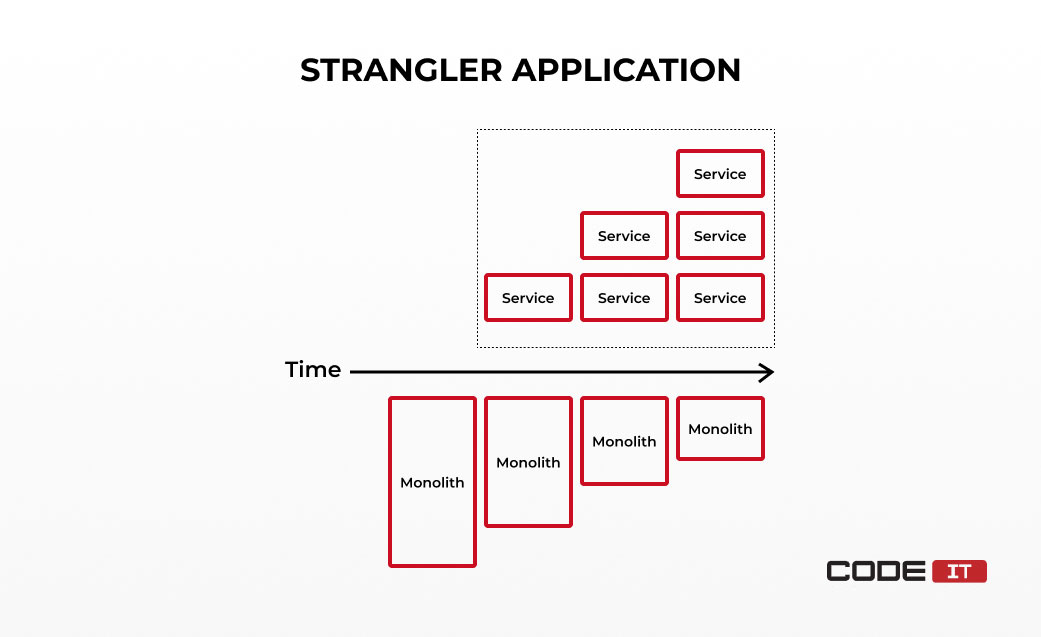
Extract the most crucial functionality first using the list of prioritized features.
New services should be slightly connected from a monolith. A perfectly refactored microservice should match the following criteria:
- service isn’t bound with a monolith logic
- service doesn’t need to call a monolith’s API gateways and provide its API
- service and monolith share a small amount of code with data synchronization mechanisms
- service needs adding new tables/fields to a database with database per service
Some of these criteria can be compromised on. However, if you create a new service that is tightly coupled with a monolith, which comprises the business logic of a feature, you risk ending up with a distributed monolithic architecture.

The term distributed monolith describes an undesirable outcome of a monolith refactoring It is characterized by extracted microservices that are highly connected or heavily dependent on a monolith with distributed transactions. Hence, the “monolith issues at scale” remain unsolved, even though an app is split into microservices.
Stage #6 outcome:
A strangler application with services being incrementally extracted from a monolith with eventual consistency models.
Microservices Use Cases and Real-World Examples
7. Implement New Features as Microservices
Add new microservices to the existing strangler application to keep developing and releasing new features during refactoring.
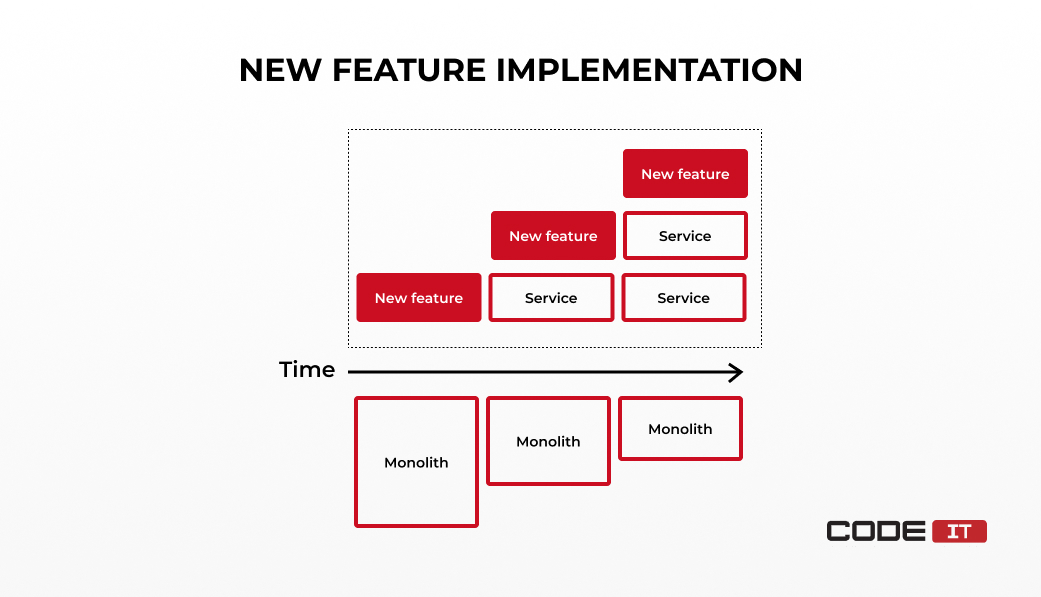
It’s crucial to implement the integration glue. It helps enable the smooth integration of new services with a monolith.
The three core components of the integration glue are:
- monolith to new service data exchange with event sourcing
- new service to monolith data exchange with inter-process communication (IPC)
- API gateway if access to both monolith and service data is required
New services should be loosely coupled with a monolith and highly cohesive. They have to keep the business logic and most of the functionality independent from a monolith.
Besides, you need to implement the microservices security best practices with real-time security monitoring to develop a stable and highly resilient application.
Stage #7 outcome:
New features developed as microservices and loosely coupled with a monolith using routing mechanisms.
Let’s explore the “at scale” issues with the monolith and how refactoring helps fix them in more detail below with integration patterns.
Get a detailed app refactoring plan

Business First
Code Next
Let’s talk
Microservices — solution to monolith issues at scale
The majority of small businesses and startups launch their digital solutions with microservices architecture. It needs less effort to develop and launch an app. However, when the project’s scale increases, most companies refactor their applications with horizontal scaling.
The refactoring of a monolith to microservices makes it easy to implement new features quickly. Moreover, it helps incorporate a lot of diverse technologies into one application.
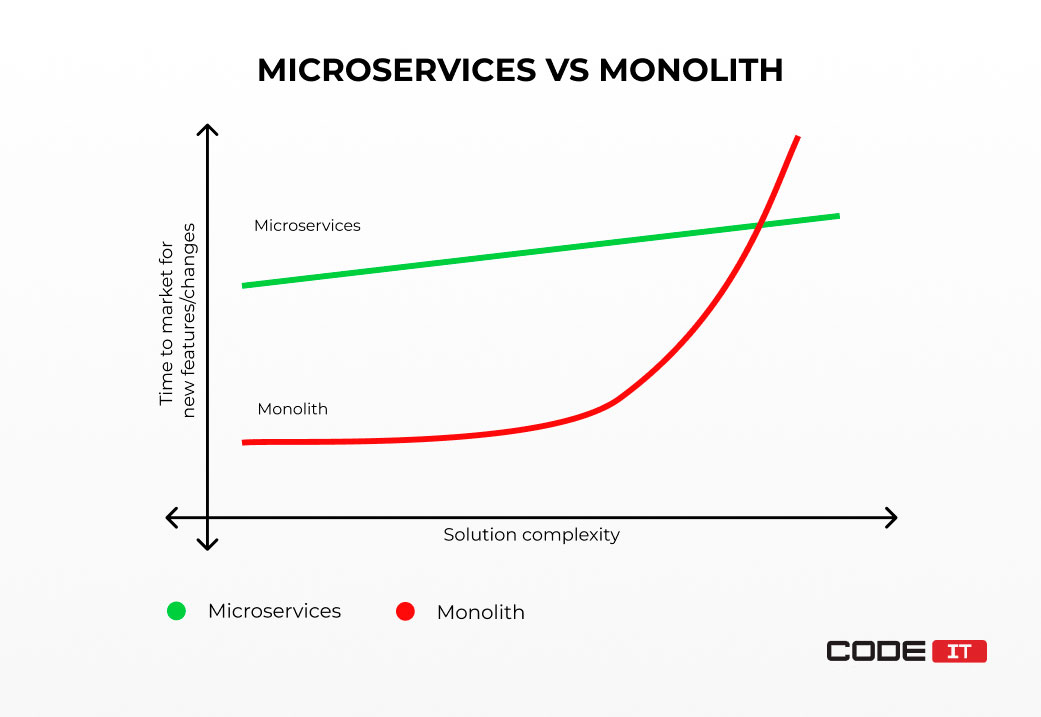
Have monolith issues in your app?

Business First
Code Next
Let’s talk
Most issues arise when companies need to scale up their monolithic application fast with infrastructure setup.
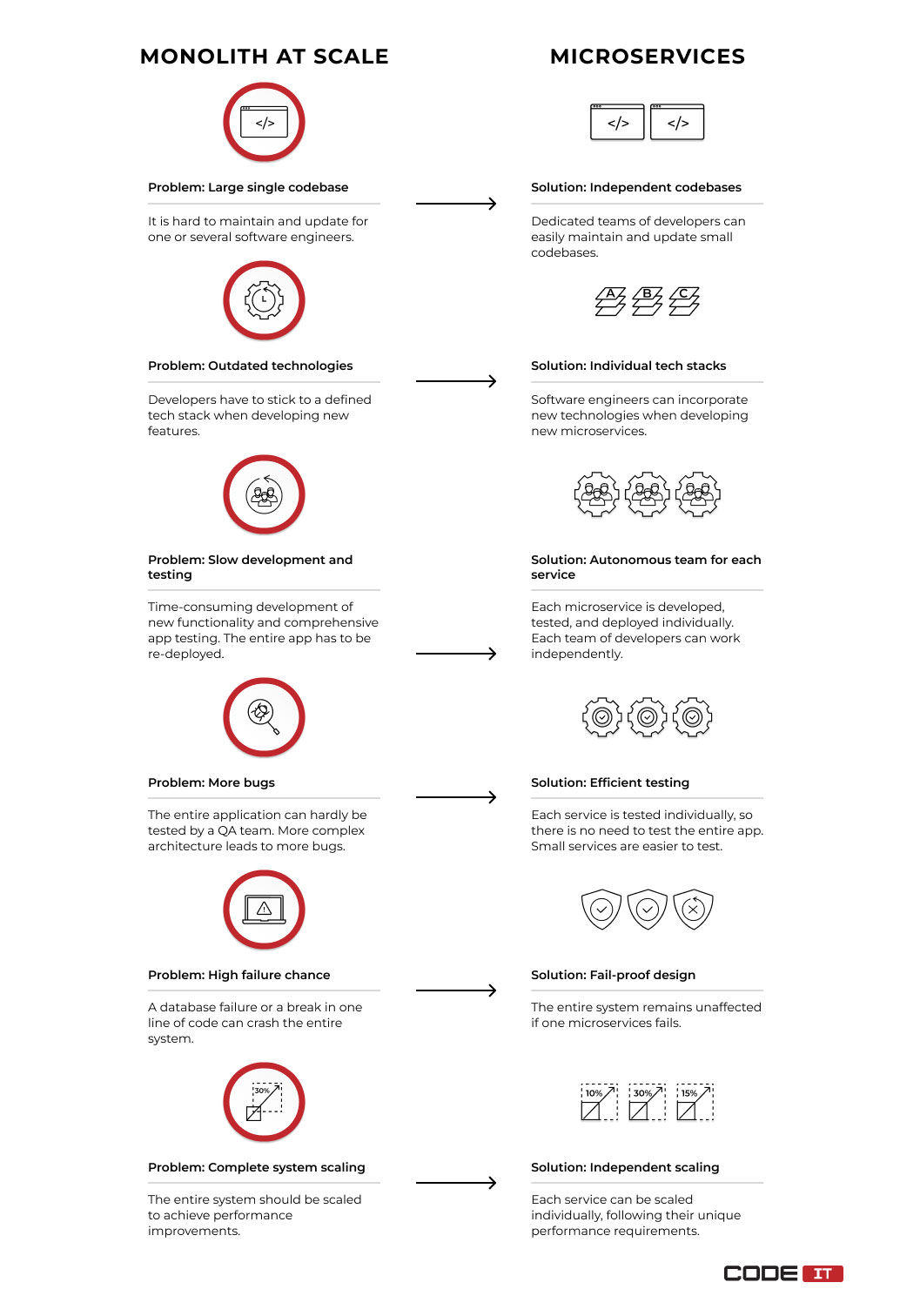
1. Slow Delivery
Monolithic applications use one codebase that comprises all the functionalities with a datastore. Since disparate features aren’t isolated, developers need to release major app updates to release even small changes. The other bottlenecks of the architecture are as follows.
- A large codebase. One developer can hardly maintain and quickly update a massive codebase.
- Outdated technologies. Developers have to stick to a defined tech stack. They can’t incorporate new technologies. In some cases, software engineers need to learn outdated technologies.
- App is slow to build and test. The continuous integration (CI) and quality assurance (QA) processes are time-consuming with a large monolithic application lacking performance testing.
Microservices-driven solution: Fault isolation is achieved because microservices are loosely coupled with automatic discovery. A failed app’s part does not affect the entire application.
Also, each service is easy to understand, maintain, test, and update for a dedicated team with centralized logging. Developers can choose an individual tech stack for new services.
2. Poor Stability
The primary stability issues with a monolithic application at scale are:
- Complicated testing. It is challenging for a QA team to test a large application comprehensively with integration testing. Moreover, the more complex an app becomes, the larger the number of bugs that appear.
- Higher app failure change. One feature failure can disrupt the entire application with poor application performance monitoring. When a database or one line of code crashes, the entire app fails.
Microservices-driven solution: Fault isolation is achieved because microservices are loosely coupled. A failed app’s part does not affect the entire application.
3. Insufficient Scalability
Developers can’t scale up certain parts of a single app with independent storage system. The limitations set by the architecture need businesses to choose from:
- compromise on the performance
- overspend on scaling up the entire application even with the cloud-first approach
Nevertheless, it’s impossible to limitlessly increase an app’s performance by adding more CPU and RAM.
Microservices-driven solution: Each service has individual performance requirements and can be scaled independently with distributed data management patterns.
Monolithic Application vs Microservices
Refactoring as strategic business decision
Monolith to microservices migration is a strategic decision that should be taken when a digital system becomes too complex for operation model.
Businesses need to invest a lot of time and resources with infrastructure-as-code. Moreover, there is a high risk of getting a distributed monolith, which won’t help you solve project issues.
It’s advisable to thoroughly analyze the possible outputs and problems you will need to tackle with end-to-end observability.
Business Benefits
The top business-side benefits of migration of monolith to microservices are as follows.
- Team scaling. The microservice architecture enables the opportunity to keep large teams of software engineers and manage them effectively.
- Predictable time to market. The rising complexity of a solution won’t affect the time needed to create and release a new feature with deployment pipelines.
- Fault isolation. The application keeps working even if one of its services fails with runtime security monitoring.
- Improved developer performance. Software engineers can use the most optimal technologies when creating new microservices from scratch with configuration servers. Also, they can better understand a small codebase of a certain service.
Business Drawbacks
Meanwhile, the process of refactoring a monolith has the following business downsides.
- Senior developers. It’s required to involve highly skilled software engineers. Besides, it may be difficult and time-consuming to assemble a team of senior developers.
- Large investments. Senior developers need to dedicate a lot of time to monolith to microservices migration. Also, it may slow down the release of new features.
- Chance of mistake. If your team of developers isn’t senior enough, you may get a distributed monolith as an outcome lacking security posture.
Pitfalls to avoid
The refactoring of a monolithic architecture poses many challenges that may lead to unsatisfactory results when handled properly. Below, you will find a list of the top pitfalls you must avoid to complete your monolith to microservices process migration process fail-free.
1. Lack of Clear Vision
Businesses need to invest large amounts of money and time in extracting services from a monolith and developing a new microservice architecture of an application with microservices development. Understanding the main purpose of the refactoring is a key to success.
It’s crucial to have all the challenges that hold a product’s development outlined and described with intelligent observability. Gain a clear understanding of how these issues can be resolved and what feasible outcomes you want to achieve when the refactoring is over.
Otherwise, there is a risk of losing the advantages of monolithic architecture without gaining any valuable benefits from using microservices with multicloud platforms.
2. Faulty Architecture Migration Outcome
Poor planning, insufficient technical expertise, and lack of defined outcomes may lead to improper results. As a consequence, businesses get an application that has an excessively complex architecture but delivers minimum to no benefits of using microservices. The foremost faulty outcomes of the migration process are as follows:
- Distributed monolith—all the services are decomposed in the ways they are still dependent on each other with synchronous communication. Changes to one service need developers to update other services, similar to a monolithic app but with an over-complex architecture.
- Data monolith—all the services are split but use a single database. In this case, changes in a database affect the entire application, so software engineers need to adjust all the services connected to the database.
- Nanoservices—an excessive monolith decomposition that results in an application comprising too many tiny services with small or incomplete functionality. As a result, the overall architecture is not efficient due to excessive interservice communication between independent nanoservices.
- Megaservice—one service that covers multiple pieces of business logic with macroservice tendencies. Megaservices can hardly be scaled up because they are similar to monolithic architecture, in a nutshell.
- Wrong cuts—servers are extracted, following a technological layer, not business logic. As a consequence, a distributed monolith is created instead of a microservice architecture with change data capture (CDC).
3. Lack of Documentation
The microservice architecture needs a business to involve different teams to develop and maintain diverse services with event-driven microservices. It’s advisable to create detailed documentation during the feature extraction and microservice architecture creation. The lack of clear documentation makes it difficult to rapidly onboard new specialists because they will need to thoroughly examine the codebase of each service.
4. Improper Data Handling
It’s crucial to clearly understand the data flow in your monolithic application to ensure you follow the best practices of refactoring with distributed tracing. It’s recommended that each microservice has a distinctive database to avoid interdependencies with other services.
If several services share a single database, there is a risk of creating a distributed monolith instead of a microservice-driven application. Moreover, the improper management of data-in-transit and at-rest may cause information integrity and performance issues.
5. Poor Team Coordination
The key peculiarity of using a microservice architecture is that different teams work on services built using various technologies with service prioritization. Insufficient communication between team members can lead to inconsistent implementation, mismatched APIs, and deployment delays with dynamic-analysis tools.
Migrate to Microservices Fail-free with CodeIT

Business First
Code Next
Let’s talk
Real-world refactoring cases
Migrating from a monolithic architecture to microservices has enabled many enterprises to overcome scalability challenges and achieve significant success with automated CI/CD pipeline. Explore the key accomplishments of major companies below.
1. Amazon Prime Video
In order to keep up with the growing number of users, delivering outstanding user experience, Amazon decided to modernize its application. The company refactored its monolithic app into the microservice architecture, extracting 12 microservices.
The migration helped the company resolve issues with its monolithic architecture, which had caused 35 major disruptions between 2010 and 2018. Switching to microservices enabled zero downtime, improved service latency by 30%, and allowed the system to handle 100,000 transactions per second with unified observability and security platform.
2. LetsGetChecked
The company provides home lab test kits & healthcare solutions for health monitoring with loosely coupled modules. Facing an increased demand during the pandemic, they were forced to optimize the application’s architecture, switching to microservices usage.
With an architecture comprising over 100 services, the company successfully doubled its weekly deployment rate with incremental deployment. Additionally, the independence of these services led to a 67% improvement in incident recovery time.
3. REWE Digital
One of the largest German e-commerce businesses has split its monolithic application into over 270 microservices with an API proxy, achieving the following benefits:
- failures isolated within services
- teams work independently, without a need to synchronize with each other
- faster deployment cycles per team
- various technology utilization with macroservices
Furthermore, the company transitioned from just two development teams to 48 autonomous teams working in parallel, enabling them to deliver new features independently and more efficiently.
Microservices Use Cases and Real-World Examples
CodeIT expertise in migration from monolith to microservices
CodeIT’s experts have completed a lot of successful refactoring projects. Read the CodeIT’s monolith to microservices case study below.
Problem
A large ad listing app with the booking functionality was developed as a monolith app. The architecture’s downsides held the project back from fast growth. Also, the developers couldn’t pick different tech stacks for implementing different features effectively.
Solution
Our team has brainstormed and developed a new architecture. We’ve identified the top three features that should have been extracted from the monolithic architecture and created a strangler application.
The three services we’ve extracted are:
- Ad management and search
- Automated email notifications
- User authentication and document validation
Wrapping up
Monolith to microservices migration is a critical business decision. Therefore, we recommend refactoring your application only if you have strong reasons, including the following:
- system struggles from monolith downsides
- you need to involve a large number of developers
- the number of features will grow fast with bounded contexts
It’s important to stick to the smart refactoring strategy to avoid the development of a distributed monolith instead of a microservices-based application. Extract features along with their business logic. Microservices need to have high cohesion and be loosely coupled.
Re-engineer your monolithic application

Business First
Code Next
Let’s talk
FAQ
Monolith refactoring is the process of decomposing an application into distinctive services that are loosely coupled with each other.
The refactoring of a monolith to microservices helps solve project issues, enlarge a team of developers, and keep new features fast despite the increasing complexity of an application.
The seven monolith to microservices migration steps are:
- Problem source discovery
- Fast solutions discovery
- Monolith optimization
- Migration approach selection
- Prioritization of features to extract
- Feature extraction
- New service implementation
The two main approaches are:
- Complete rewrite — best for small applications
- Incremental rewrite — best for large and complex apps
The foremost mistakes to avoid when moving from monolith to microservices are:
- Development of a distributed monolith instead of a microservice-based app
- Selection of a wrong refactoring approach
- Involving developers with low seniority levels
The monolith to microservices migration help solve the “monolith at scale” issues, including:
- slow delivery
- poor stability
- insufficient scalability
The more complex an app becomes, the more time it takes to develop, test, and release new features. Also, the chances of app failure increase significantly.
The migration of a monolith to microservices is a solution to the “monolith at scale” issues.
Build your ideal
software today

